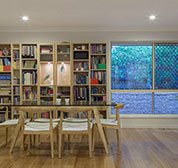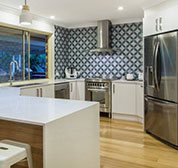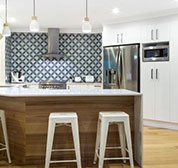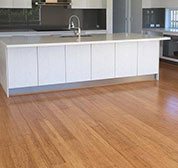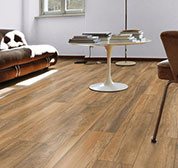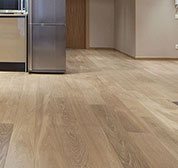Why Bamboo Flooring?
Understand bamboo flooring and its pros and cons It might be strange to imagine that a hollow, grass-like plant would serve as a durable floor covering. And yet, bamboo is quickly gaining popularity as a suitable flooring material. Here E-flooring uncovers this brilliant new resource in flooring.
Why Bamboo?
It might be strange to imagine that a hollow, grass-like plant would serve as a durable floor covering. And yet, bamboo is quickly gaining popularity as a suitable flooring material.
Holding the title of the fastest growing plant in the world, bamboo has always been one of the greenest flooring materials available. Growing an amazing 47.6 inches in a 24 hour time period, bamboo is the perfect sustainable flooring solution for the ecologically-minded consumer.
Features & Benefits of Bamboo
- Easy maintenance
Bamboo flooring cleans easily with routine dust mopping, sweeping or vacuuming. - Non-Allergenic
Bamboo flooring is ideal for allergy sufferers as it does not promote dust. - Hardness & Durability
Bamboo flooring is harder than many hardwoods and is quite resilient and dent resistant. In Japan, bamboo has served as industrial building materials so it’s certainly strong enough for your family’s flooring needs. - High moisture resistance
Bamboo flooring shares many qualities of a laminated product offering a high moisture tolerance, making it the perfect choice for all areas of your home. - Installation
Available in both solid and engineered formats, bamboo flooring is installed much like hardwood using nails, staples, adhesive or a simple floating method.
Types of Bamboo Flooring
Vertical / Horizontal BambooVertical and horizontal refer to the pattern in which the bamboo is laid and adhered together. The vertical style of bamboo flooring is constructed by adhering a number of bamboo strands together with the narrow edge facing upward creating thin lines between the laminated strips. Alternately, these bamboo strands can be adhered along the narrow edge resulting in the wider portion facing upward. This style if referred to as horizontal bamboo. Both vertical and horizontal bamboos are available in natural and carbonized options.
Strand Woven Bamboo
In addition to vertical and horizontal, a third style known as "strand-woven" bamboo is also produced. The unique process in which strand woven bamboo is constructed dramatically increases the density and hardness of the product. Unlike the other manufacturing processes, strand woven bamboo uses the entire plant. The bamboo fibers are intertwined, creating a new piece of timber with an extraordinary amount of durability. With a Janka Hardness Rating twice that of domestic oak, strand woven bamboo has earned the title of the "indestructible floor".
Carbonized Bamboo
Also known as "fumed finish", carbonized bamboo is generally of a darker "brownish" color rather than its natural blonde appearance. The term "carbonized" comes from the process in which the bamboo is steamed or boiled, caramelizing the sugar in the bamboo strands. While the rich tones of a carbonized bamboo are appealing, the carbonization process causes the floor to be approximately 30% softer than regular bamboo.
The Manufacturing Process
After an approximate 5 year maturation period, the bamboo stalks are harvested and prepped for processing. Upon arrival to the plant, the logs are sliced into individual long strips. These strips are then cut near the approximate width of the bamboo flooring planks.- Carbonization
After being cut, the bamboo strips are steamed under pressure. This process removes sugars and insects from the bamboo. The bamboo retains its natural coloring throughout the process. Darker shades of bamboo, referred to as Carbonized Bamboo have been subjected to longer periods of carbonization. - Gluing
Once the carbonization process is complete, the dried bamboo strips are then assembled either vertically or horizontally and then bonded together under tremendous weight and pressure which binds the strips together. Bamboo flooring is bonded using formaldehyde adhesives. Superior manufacturers use formaldehyde levels lower than the United States quality controls require. - Finishing
After the bamboo is hot pressed, blanks are ready for the milling process. Much like traditional hardwood, the typical bamboo flooring is designed in a tongue and groove format. Following milling, the boards are sealed with an aluminum oxide wear layer to add additional protection and durability. - Quality and Inspection
The final step in the manufacturing process is inspection and grading of the bamboo planks. The planks are separated into two categories – A and B. B quality is often sold to discount stores who use the material for their two-dollar bamboo offerings.








